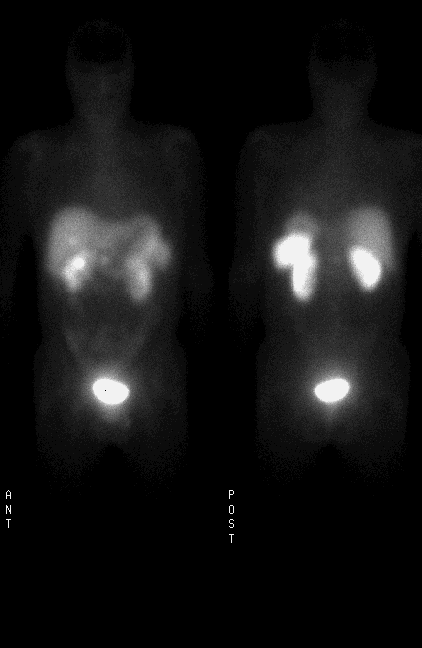Case Author(s): Gabriel De Simon, MD. and Jerold Wallis, MD. , 10/19/00 . Rating: #D3, #Q4
Diagnosis: MEN 1 syndrome with recurrent gastrinomas.
Brief history:
Recurrent diarrhea and weight loss.
Images:

Anterior and posterior images at 24 hours post injection are shown
View main image(ot) in a separate image viewer
View second image(ot).
Axial (SPECT) 4 hour delayed images of the upper abdomen.
View third image(ot).
Axial (SPECT) 24 hour delayed images of the upper abdomen.
View fourth image(ct).
Contrast enhanced axial CT images of the upper abdomen.
Full history/Diagnosis is available below
Diagnosis: MEN 1 syndrome with recurrent gastrinomas.
Full history:
51 year old male with known MEN type 1 syndrome, post distal pancreatectomy two years previously. He now represents with diarrhea, loss of weight and an elevated gastrin level of greater than 1000.
Radiopharmaceutical:
Indium 111 pentetreotide, 5.12 mCi.
Findings:
INDIUM 111 PENTETREOTIDE:
Large focus of increased activity immediately anterior to the upper pole of the right kidney, just medial to the visceral surface of the right liver lobe. On planar imaging, this might be mistaken for
renal collecting system activity, but on SPECT imaging this is clearly
not the case.
Smaller, less intense focus of increased uptake to the right of the midline, anterior to the vertebral body, more medially located and slightly superior and anterior to the above mentioned lesion.
Faint uptake overlying the inferior right lobe of the liver was felt to represent normal gallbladder activity.
CONTRAST ENHANCED DYNAMIC CT:
Three foci of contrast enhancement in the descending duodenum, the largest measuring 1.7 by 1.4 cm located anteriorly, the remaining smaller two coalescent on the posterior duodenal wall. These correspond to the larger more intense focus of uptake anterior to the upper right renal pole. There is no CT correlate for the second, less intense more medial focus of uptake demonstrated on the octreotide scan.
Discussion:
Somatostatin receptors have been demonstrated in a variety of neuroendocrine tumors and diseases with activated leukocytes. The density of these receptors is high enough to allow in vivo visualization of these lesions in most cases. Pentetreotide is a somatostatin analogue which normally accumulates in the thyroid and salivary glands, spleen, liver, and kidneys, with excretion into urinary bladder and bowel(mainly on 24 hour images). The preferred dose is about 6 mCi, allowing performance of SPECT, which increases the sensitivity of detection of octreotide receptor-expressing tissues. The majority of peptide,hormone-producing endocrine tumors originate from the islet cells of the pancreas, but may also occur in the duodenum(87% and 13% respectively, European Mallinckrodt trial:EMT). Localization of the primary tumors, as well as metastases may prove to be difficult with conventional imaging. In the EMT, conventional imaging (mainly CT)was able to localize tumors in 75% of patients with a strong clinical suspicion. Octreotide scintigraphy was positive in 84% of patients, and found additional lesions in 40%. It can therefore be of great value in localizing multiple tumor sites, and where surgery is indicated but no tumor localization was possible with MR or CT. In contrast to endocrine pancreatic tumors, all exocrine adenocrcinomas of the pancreas investigated were negative. Though surgery is the treatment of choice in most cases, long-acting somatostatin analogues have also had some benefit in treatment of neuroendocrine tumors.
Followup:
Patient had a Whipple procedure for definitive treatment. Intraoperative ultrasonography demonstrated a hypoechoic mass near the previous resection line, likely corresponding to the second, more medial focus of uptake on Octreotide scintigraphy, not detected on CT. A total of four lesions were demonstrated in the duodenum.
Major teaching point(s):
The whole-body approach of Ocreotide scintigraphy allows a very sensitive way of localizing tumors not visualized by conventional imaging, and of finding unsuspected metastatic sites.
Differential Diagnosis List
Other APUDomas, including insulinomas,glucagonomas,VIPomas and metastatic carcinoid and pheochromocytoma.
ACR Codes and Keywords:
References and General Discussion of Octreotide Scintigraphy (Anatomic field:Gasterointestinal System, Category:Neoplasm, Neoplastic-like condition)
Search for similar cases.
Edit this case
Add comments about this case
Return to the Teaching File home page.
Case number: ot006
Copyright by Wash U MO

